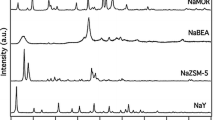Abstract
study of dihydrogen adsorbed at 77 K by the zinc-modified hydrogen forms of mordenite and ZSM-5 zeolites with the different Si/Al ratios in the framework indicated the existence of several adsorption sites connected with the modifying zinc ions. The fraction of the sites of the strongest perturbation of adsorbed molecular hydrogen with the H–H stretching frequency of ca. 3930–3950 cm-1 is the highest at the highest Si/Al ratios of 41 or 80. These sites dissociatively adsorb hydrogen at moderately elevated temperatures. Adsorption of hydrogen with the higher H–H stretching frequency of about 3970–4000 cm-1 predominates at the lower Si/Al ratios. It does not result in the dissociation of adsorbed molecules. It was concluded that the most active sites are most probably connected with the zinc ions, which compensate two distantly separated negatively charged [AlO4]- tetrahedra localized in the adjacent five- or six-membered rings on the walls of the large channels of the pentasil's framework. The sites of the weaker perturbation of adsorbed hydrogen are most probably connected with Zn+2 ions at the conventional exchangeable cationic positions with two aluminum atoms in the same five- or six-membered ring.
Similar content being viewed by others
References
T. Mole and J. R. Anderson, J. Creer, Appl. Catal. 17 (1985) 141.
Y. Ono and K. Kanae, J. Chem. Soc., Faraday Trans. 67 (1991) 669.
E. Iglesia and J. E. Baumgartner, Catal. Lett. 21 (1993) 55.
J. A. Biscardi and E. Iglesia, Catal. Today 31 (1996) 207.
H. Berndt, G. Leitz, B. Lucke and Volter, J. Appl. Catal. 146 (1996) 351, 365.
E. Iglesia, J. E. Baumgartner and G. L. Price, J. Catal. 134 (1992) 549.
V. I. Jakerson, T. V. Vasina, L. I. Lafer, V. P. Sytnyk, G. L. Dykh, A. V. Makhov and K. M. Minachev, Catal. Lett. 3 (1998) 339.
El-M. El-Malki, R. A. van Santen and W. M. H. Sachtler, J. Phys. Chem. 103 (1999) 4611.
J. A. Biscardi, G. D. Meizner and E. Iglesia, J. Catal. 179 (1998) 192.
X. Feng and W. K. Hall, Catal. Lett. 46 (1997) 11.
V. B. Kazansky, V. Yu. Borovkov, A. I. Serykh, R. A. van Santen and B. G. Anderson, Catal. Lett. 66 (2000) 39.
V. B. Kazansky, A. I. Serykh, R. A. van Santen and B. G. Anderson, Catal. Lett. 74 (2001) 55.
G. Ghiotti, A. Chiorino and F. Boccuzzi, Surf. Sci. 287/288 (1993) 228.
R. J. Kokes, Acc. Chem. Res. 6 (1973) 226.
M. J. Rice, A. K. Chakraborty and A. T. Bell, J. Phys. Chem. B104 (2000) 9987.
A. T. Bell, in Catalysis by Unique Metal Ion Structures in Solid Matrixes, G. Genti, B. Wichtelowa and A. T. Bell (eds) (Kluwer Academic Publishers, Dordrecht–Boston–London, 2000) p. 55.
G. Engelhardt, in Introduction to Zeolite Science and Practice, Chapter 8, H. van Bekkum, E. M. Flaningen and J. C. Jansen (eds) (Elsevier, 1991) p. 285.
V. B. Kazansky, V.Yu. Borovkov, A. I. Serykh, R. A. van Santen and P. J. Stobbelar, PCCP 1 (2000) 2881.
J. N. Armor, in Catalysis by Unique Metal Ion Structures in Solid Matrixes, G. Genti, B. Wichtelowa and A. T. Bell (eds) (Kluwer Academic Publishers, Dordrecht–Boston–London, 2000), p. 21, p. 25.
H. Y. Chen, El. M. El. Malki, X. Wang and W. M. H. Sachtler, ibid, p. 75.
T. Beutel, J. Y. Sarkany and W. M. H. Sachtler, J. Phys. Chem. 100 (1996) 845.
G. D. Lei, B. J. Adelman, J. Sarkany and W. M. H. Sachtler, Appl. Catal. B112 (1995) 245.
W. Grunert, N. W. Hayes, R. W. Joiner, E. S. Spiro, M. R. H. Siddiqui and G. N. J. Baeva, J. Phys. Chem. 98 (1994) 10832.
R. A. van Santen, G. M. Ghidomirov, A. A. Shubin, A. L. Yakovlev, L. A. M. M. Barbosa, in Catalysis by Unique Metal Ion Structures in Solid Matrixes, G. Genti, B. Wichterlowa and A. T. Bell (eds) (Kluwer Academic Publishers, Dordrecht-Boston-London, 2000) p. 187.
A. L. Yakovlev, A. A. Shubin, G. M. Ghidomirov and R. A. van Santen, Catal. Lett. 70 (2000) 175.
V. B. Kazansky, A. I. Serykh and A. T. Bell, Catal. Lett. 83 (2002) 191.
A. A. Shubin, G. M. Zhidomirov, V. B. Kazansky and R. A. van Santen, Catal. Lett.
Author information
Authors and Affiliations
Rights and permissions
About this article
Cite this article
Kazansky, V., Serykh, A., Anderson, B. et al. The Sites of Molecular and Dissociative Hydrogen Adsorption in High-Silica Zeolites Modified with Zinc Ions. III DRIFT Study of H2 Adsorption by the Zeolites with Different Zinc Content and Si/Al Ratios in the Framework. Catalysis Letters 88, 211–217 (2003). https://doi.org/10.1023/A:1024026225712
Issue Date:
DOI: https://doi.org/10.1023/A:1024026225712



